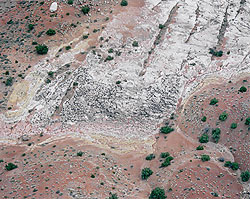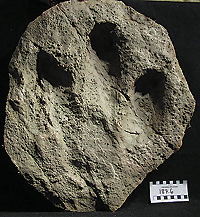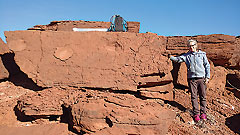 Last month we introduced the Dinosaur Tracker’s Research Group activities, around Moab and elsewhere in Utah’s fossil-rich Dinosaur Diamond, from Moab and Blanding to Price and Vernal, and into western Colorado. There are hundreds of dinosaur tracksites in this large area from before, during and after the Triassic-Jurassic and Cretaceous “age of dinosaurs.” Moab gives its name to the Moab Megatracksite. A megatracksite (literally a very large tracksite) is a very extensive rock surface or package of strata containing fossil footprints almost continuously over a large area. They hg have also been called Dinosaur Freeways. Instead of local footprints around a small pond or oasis, think of a coastal plain, like today’s Gulf of Mexico, with footprints made for hundreds of miles. On the west side of Arches National Park one can find such extensive track-rich layers. The Stomping Ground site with more than 2000 footprints is part of this ‘megatracksite’ situated wherever one can see the top of the Entrada Sandstone. This rock unit is Middle to Upper Jurassic in age (about 160 million years) and is overlain by a thin layer of shallow marine sediment called the Summerville Formation. It is in fact were the sea came into the Moab area, briefly by geological standards, creating a coastal plain. Almost everywhere this layer is found, north, south, east and west of Arches one may finding tracks: for example at the Bull Canyon interpretative site, at the head of Castle Valley, or far to the west along the Escalante. So, the Moab Megatracksite appears to cover thousands of square miles.
Last month we introduced the Dinosaur Tracker’s Research Group activities, around Moab and elsewhere in Utah’s fossil-rich Dinosaur Diamond, from Moab and Blanding to Price and Vernal, and into western Colorado. There are hundreds of dinosaur tracksites in this large area from before, during and after the Triassic-Jurassic and Cretaceous “age of dinosaurs.” Moab gives its name to the Moab Megatracksite. A megatracksite (literally a very large tracksite) is a very extensive rock surface or package of strata containing fossil footprints almost continuously over a large area. They hg have also been called Dinosaur Freeways. Instead of local footprints around a small pond or oasis, think of a coastal plain, like today’s Gulf of Mexico, with footprints made for hundreds of miles. On the west side of Arches National Park one can find such extensive track-rich layers. The Stomping Ground site with more than 2000 footprints is part of this ‘megatracksite’ situated wherever one can see the top of the Entrada Sandstone. This rock unit is Middle to Upper Jurassic in age (about 160 million years) and is overlain by a thin layer of shallow marine sediment called the Summerville Formation. It is in fact were the sea came into the Moab area, briefly by geological standards, creating a coastal plain. Almost everywhere this layer is found, north, south, east and west of Arches one may finding tracks: for example at the Bull Canyon interpretative site, at the head of Castle Valley, or far to the west along the Escalante. So, the Moab Megatracksite appears to cover thousands of square miles.
Almost everywhere one finds this surface there are only two common track types representing large carnivorous theropod dinosaurs: the specialist footprint names are Megalosauripus and Therangospodus, for large- and medium-sized tracks. Megalosauripus (meaning track of a Megalosaurus-like species) is easy to remember as Megalosaurus was the first dinosaur ever described, in 1824, from the Middle Jurassic of Oxfordshire, England. [Its anatomy is different from Allosaurus, the famous late Jurassic theropod, also the Utah state fossil].
Megalosaurs grew up of 25-30 feet (~8-9 m) long and probably weighted a ton. The Moab footprints, up to 16 inches (40 cm long), allow us to estimate body size. Multiply theropod footprint length by 5 to get leg length or hip height (80 inches ~2 m) and again multiply x3 for body length: in this case ~6m or 20 feet, but still likely a fierce handful. Nice coincidence that we have Megalosaurus-like tracks at the Megatracksite. But why thousands of carnivore tracks and almost zero herbivore  tracks (only two sauropod tracks between Moab and Escalante)? What did so many carnivores eat? Each other? This is one of the mysteries of the Early and Middle Jurassic: so many theropod trackways. What was the ecology? The sand dunes deposits below the megatracksite contain small bird-sized theropod tracks, (see next month’s tracker bulletin) while marine layers above contain pterosaur tracks. So did differences in the environment control the ecology? Large theropods may have liked to roam wide-open, beach-like coastal plain spaces in search of prey. Some paleontologists think they moved around a lot so small numbers likely made many tracks.
tracks (only two sauropod tracks between Moab and Escalante)? What did so many carnivores eat? Each other? This is one of the mysteries of the Early and Middle Jurassic: so many theropod trackways. What was the ecology? The sand dunes deposits below the megatracksite contain small bird-sized theropod tracks, (see next month’s tracker bulletin) while marine layers above contain pterosaur tracks. So did differences in the environment control the ecology? Large theropods may have liked to roam wide-open, beach-like coastal plain spaces in search of prey. Some paleontologists think they moved around a lot so small numbers likely made many tracks.
Visit Moab Giants at 112 UT-313, just 11 miles north of downtown Moab.
Starting February 14th, Moab Giants will be open 10am - 6pm daily.